Module 4 Intro
| Site: | MoodleHUB.ca 🍁 |
| Course: | Biology 20 SS |
| Book: | Module 4 Intro |
| Printed by: | Guest user |
| Date: | Wednesday, 24 December 2025, 4:49 AM |
Description
Created by IMSreader
Table of contents
- 1. Module 4 Intro
- 1.1. Big Picture
- 1.2. In this Module
- 1.3. Lesson 1 Intro
- 1.4. Page 2
- 1.5. Page 3
- 1.6. Page 4
- 1.7. Lab
- 1.8. Page 6
- 1.9. Page 7
- 1.10. Lesson 2 Intro
- 1.11. Page 2
- 1.12. Page 3
- 1.13. Page 4
- 1.14. Page 5
- 1.15. Page 6
- 1.16. Lesson 3 Intro
- 1.17. Page 2
- 1.18. Page 3
- 1.19. Page 4
- 1.20. Page 5
- 1.21. Lesson 4 Intro
- 1.22. Page 2
- 1.23. Page 3
- 1.24. Page 4
- 1.25. Page 5
- 1.26. Page 6
- 1.27. Module Summary/Assessment
- 1.28. Module Glossary
1. Module 4 Intro
Module 4—Mechanisms of Population Change
Module Introduction
In this module you will examine how populations evolve or change over time. You will look at the processes, requirements, and evidence for evolution. This module will use the ecological terms discussed in Module 3 and relate them to population change. Prior knowledge about the role sexual reproduction plays in creating change will be explored.
Humans were not always the emotionally and mentally complex beings that they are today. Could you imagine what the world would be like if nothing had changed from the age of dinosaurs or from the prehistoric time of Neanderthals? How have people become such different animals?
Looking at ancestry helps us to see where new species branch off from their origins. Knowing how organisms are classified, as you learned in Module 3, can show where new species arise by tracing backwards through the levels of classification. It is a method for tracing ancestry. In order to hypothesize why organisms diversify as Earth ages, we must look at factors such as genetic mutation, sexual reproduction, and survival of the fittest. There are several theories that serve as the basis for modern ideas of evolutionary change. Researchers and scientists have found evidence that they propose is proof that species have evolved from ancestral forms. As you work through this module, these ideas will help you explore the question “How do populations evolve?” This will lead you to predict how new species can arise.
By the end of this module you will have completed lesson assignments that are to be marked by your teacher and others that help to build confidence in your ability to understand, interpret, and express key course concepts. Everything should be saved in your course folder so that you are able to review pieces of information for exams, project work, or discussions.
1.1. Big Picture
Module 4—Mechanisms of Population Change
 Big Picture
Big Picture

© Christian Darkin/Dreamstime
Have you ever heard of or seen one of the “Planet of the Apes” movies? In these shows, apes had evolved into intelligent and advanced beings that took over the planet from humans. The premise was that they continued to evolve and humans did not.
Take some time to look at the illustration above. What thoughts come to mind when you look at it? Did the word evolution pop into your head? Have you ever considered the idea that humans are related to rodents? What kind of proof exists for the illustration above to be true? Is evolution still occurring or is it finished, as the illustration seems to indicate? As you look at the illustration, you may ask yourself how the blob became the sea creature that became the human.
In this module you will learn how a population of “blobs” evolved into a population of sea creatures as a stage toward another movement of evolution. You will have to think in terms of enormous amounts of time and many, many generations of organisms. Some of the ideas about genetic variety and the inheritance of characteristics will be familiar to you from Grade 9 Science.
You will explore the following essential questions in this module:
- How do mutations create species variability?
- Why is sexual reproduction important to the process of evolution?
- How do theories explaining evolutionary change compare?
- What theories attempt to explain the pace of evolutionary change?
- What proof is there that present-day species evolved from ancestral forms?
- What conditions are necessary for speciation?
1.2. In this Module
Module 4—Mechanisms of Population Change
In This Module
Lesson 1—Adaptation, Variation, and Natural Selection
Unless you are an identical twin, the only other human who looks the same as you is your reflection. Humans have many differences between them that create unique individuals. In this lesson you will look at these variations and see how they can help humans survive.
The following questions will be explored in this lesson:
- How do mutations create species variability?
- Why is sexual reproduction important to the process of evolution?
Lesson 2—Developing Theories to Explain Change
Modern theories explain evolution on a global scale. There are also theories that became the foundation for how scientists view evolution within populations.
The following questions will be explored in this lesson:
- How do theories explaining evolutionary change compare?
- What theories attempt to explain the pace of evolutionary change?
Lesson 3—Evidence for Evolution
You have seen the proof supporting evolution if you have ever looked at a dinosaur fossil. Organisms have changed over time, and there is a substantial amount of evidence to show these changes.
The following question will be explored in this lesson:
- What proof is there that present-day species evolved from ancestral forms?
Lesson 4—How New Species Form
Dinosaurs and humans never existed during the same time period. Humans (Homo sapiens) became a species about 150 million years after dinosaurs ruled Earth.
The following question will be explored in this lesson:
- What conditions are necessary for speciation?
 Module Assessment
Module Assessment
You will be graded according to the work you complete for the lesson assignments and the module project. The module project is the final assignment for Module 4. See the Module Summary and Assessment section for more information about the module project.
1.3. Lesson 1 Intro
Module 4—Mechanisms of Population Change
Lesson 1—Adaptation, Variation, and Natural Selection
 Get Focused
Get Focused
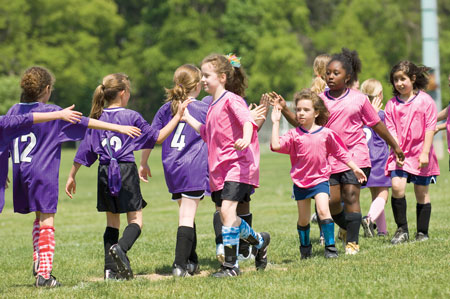
© Bonnie Jacobs/Dreamstime
The girls on a soccer team are all very close in age, but they may not all have the same skill level. You’ve probably played on a sports team with players of different abilities. Why are some people better soccer players then others? If all individuals had identical playing ability, how would you pick an MVP? What about picking a goalie? How could you choose the best player to put on the all-star team?
Evolution, like a soccer team, depends on individuals having different characteristics. Individuals with helpful characteristics will be able to survive better. How is it decided if a characteristic is helpful or not helpful?
You may have noticed that individuals from the same family look similar. Maybe you have your mom’s nose or the same eye colour as your dad. Are you a good soccer player? Are your parents good soccer players? Some characteristics can be passed from one generation to the next. How have these characteristics helped you survive and thrive? What characteristics have made your life more difficult?
In this lesson you will look at the differences or variations that exist within species, how variations are created, and what process leads to changes in populations.
In this lesson you will explore the following essential questions:
- How do mutations create species variability?
- Why is sexual reproduction important to the process of evolution?
 Module 4: Lesson 1 Assignment
Module 4: Lesson 1 Assignment
You teacher-marked Module 4: Lesson 1 Assignment requires you to submit a response to the following:
- TR 1. Peppered Moth Simulation
- Watch and Listen: Sickle Cell Anemia: An Advantage or a Disadvantage?
- Watch and Listen: The Peacock and Natural Selection
- TR 2. Selective Pressures
- LAB: Finch Beak Depth
You can access your Module 4: Lesson 1 Assignment. You can print off the assignment or save the download to your computer. Your answers can be saved on this document to your course folder.
The other questions in this lesson are not marked by the teacher; however, you should still answer these questions. The Self-Check and Try This questions are placed in this lesson to help you review important information and build key concepts that may be applied in future lessons.
After a discussion with your teacher, you must decide what to do with the questions that are not part of your assignment. For example, you may decide to submit to your teacher the responses to Try This questions that are not marked. You may decide to record the answers to all the questions in the lesson and place those answers in your course folder.
1.4. Page 2
Module 4—Mechanisms of Population Change
 Explore
Explore
 Read
Read
variation: visible or invisible differences between individuals
adaptation: a beneficial variation that helps an organism survive
mutation: a change in the genetic material of an organism (DNA)
Variation is all around you—it’s the differences between all living things. No two puppies or humans look and behave exactly the same. Some variations may give an organism a survival advantage, some may cause a disadvantage, and some will not make a difference in the organism’s survival.
A variation that gives a survival advantage to an individual is called an adaptation. Adaptations allow an individual to survive and reproduce. When an organism reproduces, it can pass on adaptations to its offspring, giving them the same survival advantages. These adaptations continue to be passed on from parent to offspring over many generations as long as the adaptation gives the organism a survival advantage.
If the environment changes, an adaptation that once gave a survival advantage may now give a survival disadvantage to an organism. In the new environment, the organism will not survive to pass on its genetic information.
Variations can be created during sexual reproduction (when genetic material from both parents is mixed up) or through mutations.
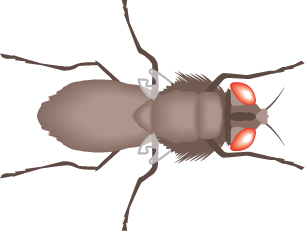
Read pages 114 to 117 in the textbook and page 118 to “Natural Selection.” You will become familiar with variations, adaptations, and mutations.
 Self-Check
Self-Check
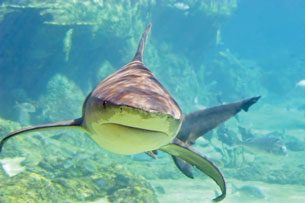
© Ian Scott/shutterstock
SC 1. Sharks have an excellent sense of smell. Is smell an adaptation?
SC 2. Give an example of how sexual reproduction leads to variations among individuals in a population.
SC 3. What is the difference between a mutation in a somatic cell as compared to a mutation in a reproductive cell?
SC 4. Give an example of a mutation that provides a selective advantage.
SC 5. Give an example of a mutation that provides a selective disadvantage.
 Self-Check Answers
Self-Check Answers
SC 1. Yes. Smell helps sharks survive by being able to find food.
SC 2. Kittens with the same parents can have many different looks based on the inherited combinations of genes that can occur during sexual reproduction.
SC 3. A mutation in a somatic cell cannot be passed on to the next generation. A mutation in a reproductive cell may be passed on to succeeding generations.
SC 4. An example of a selective advantage is a mutation in houseflies. This mutation makes the insects resistant to the insecticide called DDT. This situation is only advantageous if DDT is being used because the flies with the mutation will have a better chance of survival and reproduction (survival of the fittest).
SC 5. An example of a selective disadvantage can also be the mutation in houseflies that makes them resistant to DDT. This mutation reduces the growth rate of these flies. If DDT is not present, those flies will be less likely to survive and reproduce because of their size (survival of the fittest).
 Discuss
Discuss
How does sexual reproduction lead to variation among individuals in a population? Create a thorough response to this question. Post your response in the discussion area, and view the other posted responses. Is your explanation easy to understand when compared to classmate responses? Will you make any changes to your explanation after reading other student explanations? Make any changes you like and repost your final response to the question. Your teacher may choose to make this posting an assignment question.
1.5. Page 3
Module 4—Mechanisms of Population Change
 Try This
Try This
TR 1. Peppered Moth Simulation
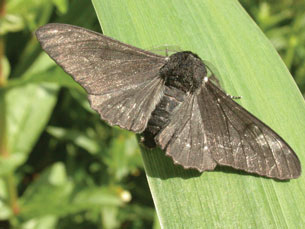
© Steve McWilliam/shutterstock
Use the peppered moth simulation to see how a variation that at one time gave a selective advantage became a disadvantage when the environment changed.
The peppered moth (Biston betularia) has two colour variations in its population—light and dark. Before 1848, the dark variation was very rare. In the middle of the eighteenth century, the Industrial Revolution started to change the peppered moths’ environment. The soot released from industries covered trees and darkened the forest environment. After the Industrial Revolution, 90% of the peppered moths were of the dark colour variation. What caused this change in colour variations?
Directions
Step 1: Open the Gizmo: Natural Selection.
Step 2: Read and follow the steps in the “Exploration Guide.” Try to answer the questions as you go through the guide.
Step 3: After you have run this simulation for a light and dark forest, try the Assessment Questions listed below the simulation.
Step 4: Answer questions 1 through 3 for the Peppered Moth Simulation in your Lesson 1 Assignment. Also save your responses in your course folder.
 Read
Read
mutagen: something that causes an increased rate of mutation
Mutations are changes in the genetic material (DNA) of an organism. Mutations are naturally occurring at a steady rate in populations. This rate can be increased if mutagens are introduced into the environment.
Common mutagens include the following:
- X-rays
- nuclear rays
- UV rays
- some chemical compounds
selective advantage: an organism’s variations increase its chances of surviving
selective disadvantage: an organism’s variations reduce its chances of surviving
What happens when a mutation is passed on to offspring?
- Some mutations are harmless and have no effect.
- Some mutations may create a new variation that provides a selective advantage and increases the offspring’s chances of survival.
- Some mutations may create a new variation that provides a selective disadvantage and reduces the offspring’s chances of survival.
Next is an example of a mutation creating a variation in a population of fruit flies.
Parent fruit flies were bombarded with X-rays. The parents then mated with healthy fruit flies, and the offspring had many mutations. The following image shows examples of some of these mutations.
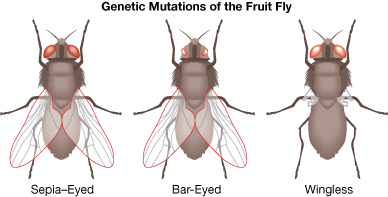
The wingless mutation will cause a disadvantage to the fly, and the offspring likely will not survive to reproduce. Since the offspring doesn’t reproduce, it will not pass on the disadvantageous mutation.
 Watch and Listen
Watch and Listen
Sickle Cell Anemia: An Advantage or a Disadvantage?
Sickle-cell disease is caused by a chance mutation in the hemoglobin molecule found in red blood cells. The mutated gene is passed on from generation to generation. This disorder causes red blood cells to become crescent-shaped instead of round and smooth. (See “Figure 4.4” on page 117 of the textbook.) This change in shape causes blood clots and many other medical problems.
There is an advantage to the sickle-cell gene. Do an Internet search to find the advantage of having one of the sickle-cell genes. Try using the keywords “pbs evolution library sickle cell” to see if you can find a video about sickle cells.
Discuss, either orally or in writing, the following questions:
If you knew you had the sickle-cell gene, would you choose to have children? Would the negatives prevent you from having children? Or would the positives outweigh the negatives? Prepare your thoughts, and post them in the discussion area. How do your thoughts compare with those of your classmates? Once you have read other postings, consider your answers. You may modify your response before submitting your final discussion as part of the Lesson 1 Assignment.
Click to view the marking rubric for this activity.
1.6. Page 4
Module 4—Mechanisms of Population Change
 Read
Read

© Scott A. Maxwell / LuMaxArt/shutterstock
Natural selection determines what variations will survive and what variations will die out. Only those organisms best adapted to the environment will survive and pass on their genetic characteristics to the next generation. Those organisms less adapted will not survive, and their traits will not be passed on. For example, the fast and fit figurines in the illustration to the left will survive the stomping attack of the giant stick man. They will be able to reproduce and pass on to their offspring the characteristics that helped them survive. In time, the characteristics of the population change due to the surviving traits. Charles Darwin developed his theory
natural selection: the process that results when the characteristics of a population of organisms change because individuals with certain inherited traits survive specific local environmental conditions and, through reproduction, pass on their traits to their offspring
sexual selection: a type of natural selection where characteristics are selected based on mate preferences
of natural selection to explain how populations change or evolve over time. The development and evidence supporting this theory will be discussed in more detail in Lesson 2.
Read page 118 of the textbook, starting at “Natural Selection.” Continue reading up to “Section 4.1 Summary” on page 121. You may skim over the Thought Labs.
The desire to mate is strong in all organisms, and it creates a strong selection pressure. In some cases, the mates’ selective pressure is oblivious to other environmental selection pressures. Selecting characteristics based on attracting a mate is called sexual selection.
 Watch and Listen
Watch and Listen
The Peacock and Natural Selection
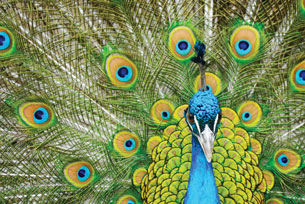
© Eric Gevaert/shutterstock
Have you ever wondered why the peacock has evolved a beautiful, long tail? The theory of sexual selection in peacocks is explored in a video found on the PBS website. To find this video, type in the keywords “pbs evolution library peacock tale.” If this video is unavailable to you, continue searching the Internet for answers to the following question:
- Why do male peacocks have long, beautiful tails that make it more difficult to escape from predators?
Explain your answer using images, text, or a combination of both. Your explanation could be in the form of a comic, a story, or a summary. Place this explanation in your course folder and in the Lesson 1 Assignment.
Click to view the marking rubric for this activity.
| 4 | 3 | 2 | 1 | |
|---|---|---|---|---|
| Accuracy of Explanation | The explanation is very accurate and detailed. | The explanation is accurate and detailed. | The explanation is accurate. | The explanation is inaccurate. |
| Clarity of Explanation | The explanation is very easy to interpret and understand. | The explanation is easy to interpret and understand. | The explanation is somewhat difficult to understand. | The explanation is difficult to understand. |
 Read
Read
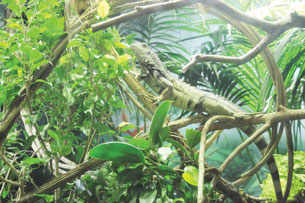
© Natallia Rasadka /shutterstock
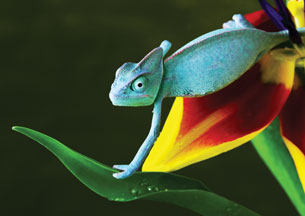
© Sebastian Duda/shutterstock
Abiotic and biotic environmental conditions can exert selective pressure on a population by selecting for certain characteristics. These selected characteristics allow the individual to survive. In the photos above, which of the two lizards is more likely to be preyed upon?
Actually, both the iguana and the chameleon are adapted to blend into or mimic their environment. If the environment of each lizard were to change drastically, and they were no longer camouflaged, the lizards could be in greater danger than those that blend in better.
In the peppered moth activity, the soot darkening the forest is an example of an abiotic environmental condition exerting a selective pressure on the population of peppered moths. The agent of this selection—the blue jay—is biotic. The soot-darkened forest selected for the dark-coloured moths and against the light-coloured moths. Therefore, the dark-coloured moth population increased and the light-coloured moth population decreased.
Selective pressure can also be exerted by a biotic component in the environment, as was observed with sexual selection. Predators are another example of a biotic component in the environment exerting a selection pressure.
 Try This
Try This
TR 2. Selective Pressures
Answer the TR 2. Selective Pressures questions in the Lesson 1 Assignment.
1.7. Lab
Module 4—Mechanisms of Population Change
 Lab: Finch Beak Depth
Lab: Finch Beak Depth
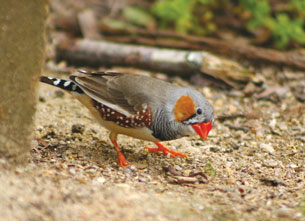
© Greg Atkinson/shutterstock
Environmental factors, adaptation, variation, and mutation all play a role in the struggle for survival among individuals in a population. Charles Darwin based his theories of natural selection primarily on his observations of finches in the Galapagos Islands. In this lab you will determine the effect of environmental conditions on finch beak depth.
Problem
How does the depth of finch beaks vary with periods of drought or heavy rain?
Procedure
Step 1: You will be using a simulation to explore the answer to this lab problem. Open the Finch Beak Lab simulation.
Step 2: Open and follow the steps in the Exploration Guide.
Step 3: Record your data in a table similar to the one below.
Step 4: Answer the Analysis and Conclusion questions in your Lesson 1 Assignment. Save your responses in your course folder.
Data and Observations
Beak Depth and Finch Population Sizes for Varying Average Inches of Rainfall
Average Inches of Rainfall |
Average Depth of Beak |
Average Population of Finches |
1 |
|
|
5 |
|
|
10 |
|
|
Analysis
- During what part of the year does the finch population increase? Why do you think this is so?
- How did the number of finches change after the five years of drought? Why do you think this is so?
- What happens to the average beak depth after the five-year drought?
- During years of drought, the smaller, softer seeds are quickly eaten up, leaving behind only the larger, tougher seeds that are harder to crack and more difficult to find under the baked soil. What kinds of beaks are more useful in these conditions? Why? How does this information relate to your answer to question 3?
- Assuming that beak depth is a genetic trait, and that an individual finch cannot change the shape of its own beak, how did the change in average beak depth actually occur during the drought? Explain in detail.
- When rainfall is above average in the Galapagos Islands, a higher proportion of seeds are small. How does this explain the trend in beak size you observed after five years of excess rain?
Conclusion
- How did the finch population size and beak depth respond to drought years? What about in years of heavy rainfall?
- What selection pressure caused the change in beak depth? Explain.
1.8. Page 6
Module 4—Mechanisms of Population Change
 Reflect and Connect
Reflect and Connect
 Self-Check
Self-Check
SC 6. Complete this Self-Check exercise.
 Reflect and Connect
Reflect and Connect
Complete one of the following activities. Place the finished product in your course folder.
- Create a mind map to show the connections between mutations, sexual reproduction, variation, and natural selection.
- Give a visual or text-based example or representation for each of the following:
- sexual selection
- biotic selective pressure
- abiotic selective pressure
- variation
- natural selection
- sexual selection
- Make two lists using text or images. The first list should include organisms with characteristics that could have evolved by sexual selection. The second list should include organisms with features that likely evolved due to natural selection where the organism’s food source could have been the selective pressure.
 Reflect on the Big Picture
Reflect on the Big Picture
You have seen the importance of variation in the survival of a species and learned how variation affects the evolution of a population. A population needs variation in order to survive environmental changes. When one organism has an advantage because of a variation, it can survive. When the organism reproduces, it passes on the adaptation to its offspring. Eventually, over time and many generations, most of the population will have this adaptation. The accumulation of adaptations causes the population to evolve.
Can you look at your own life and see examples of variation? Do any of these variations give you or your friends an advantage? Make a list of these variations, and discuss them with a friend or a classmate before you get started on your module project.
Module Project
You will create a game, play, or podcast for this project. Participants must answer a variety of questions while playing the game, watching the play, or viewing the podcast. Have you read through the requirements for the module project yet? If not, you can find the requirements in the Module Summary and Assessment. Read through the project information so you understand how you will be assessed on this major project.
- Read through the requirements for the module project in the Module Summary and Assessment.
- Decide on a theme. Some possible theme ideas include human evolution, extinct species, a day in the life of Charles Darwin, controversial evolution, dinosaurs, or any other theme you can think of.
- You have learned enough information in this lesson to answer the first three questions in the assignment. Jot down notes on these three questions.
- How is sexual reproduction significant in creating variation within populations?
- How can mutations improve or harm an individual organism’s chances for survival and reproduction?
- How do variations lead to the evolution of populations?
- How is sexual reproduction significant in creating variation within populations?
- Brainstorm ways of getting this information into your game, play, or podcast in a creative way. You may work in partners to complete this assignment. You may like to brainstorm with another student even if you are not working together.
- Place your work in progress in your course folder. You will revisit this work in Lesson 2.
 Going Beyond
Going Beyond
Choose one of the following two activities to complete.
- How does natural selection explain the development of the human eye? What type of evidence do scientists have that this theory might be correct? The PBS website contains content that specifically discusses the eye, and it contains a link to a video that helps explain how natural selection may have created the eye. Use an Internet search engine to find this site by typing in the keywords “pbs evolution library.” Once at this site, you can search for “evolution of the eye.” Put your answers in your course folder.
-
Read a chapter from Darwin’s book, The Origin of Species. In “Chapter 4: Natural Selection,” Darwin discusses sexual selection and gives some examples of natural selection. You may find the language difficult but, at the same time, interesting. Take an example of natural or sexual selection from this chapter and, in your own words, add it to your portfolio.
 Module 4: Lesson 1 Assignment
Module 4: Lesson 1 Assignment
Submit your Module 4: Lesson 1 Assignment to your teacher.
1.9. Page 7
Module 4—Mechanisms of Population Change
 Lesson Summary
Lesson Summary
In this lesson you explored the following essential questions:
- How do mutations create species variability?
- Why is sexual reproduction important to the process of evolution?
Soccer takes balance, timing, speed, and agility. Some of these characteristics are passed on from one generation to the next, and some are not. Some people will be good soccer players, some people will get better with practice, and other people will just never be fast enough to keep up with the others.
In this lesson you have learned that variations are created by mutations and sexual reproduction. Variations that allow organisms to survive in their environment are called adaptations. These adaptations will then be passed on to the next generation. Over time, these variations will change characteristics in a population and lead to the evolution of populations.
In Lesson 2 you will explore two theories to help understand how evolution occurs.
Lesson Glossary
adaptation: a beneficial variation that helps an organism survive
mutagen: something that causes an increased rate of mutation
mutation: a change in the genetic material of an organism (DNA)
natural selection: the process that results when the characteristics of a population of organisms change because individuals with certain inherited traits survive specific local environmental conditions and, through reproduction, pass on their traits to their offspring
selective advantage: an organism’s variations increase its chances of surviving
selective disadvantage: an organism’s variations reduce its chances of surviving
selective pressure: environmental conditions that select for certain characteristics of individuals and select against other characteristics
sexual selection: a type of natural selection where characteristics are selected based on mate preferences
variation: visible or invisible differences between individuals
1.10. Lesson 2 Intro
Module 4—Mechanisms of Population Change
Lesson 2—Developing Theories to Explain Change
 Get Focused
Get Focused
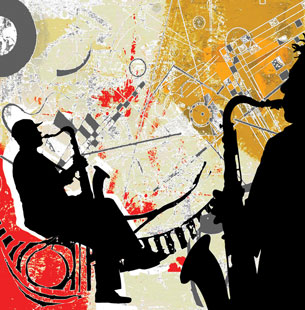
© TAOLMOR/shutterstock
If your parents and friends had to explain why your taste in music evolved from punk rock in January to classical jazz in September, they would have to make a theory based on their observations. Since your parents like classical jazz, perhaps they think your taste in music came from them. Meanwhile, your friends may observe that you lost your punk rock collection and had to resort to listening to whatever music your parents had. Which theory do you think best explains your situation?
Evolutionary scientists, such as Charles Darwin and Jean Baptiste Lamarck, used their observations to explain the phenomenon of evolution. What scientist ended up making the correct conclusions?
In this lesson you will explore the following essential questions:
- How do theories explaining evolutionary change compare?
- What theories attempt to explain the pace of evolutionary change?
 Module 4: Lesson 2 Assignment
Module 4: Lesson 2 Assignment
Your teacher-marked Module 4: Lesson 2 Assignment requires you to submit a response to the following:
- TR 2. Answering Darwin’s Questions
- TR 3. The Pace of Evolution
- Reflect and Connect: Applying and Comparing Theories of Evolution
You can access your Module 4: Lesson 2 Assignment. You can print off the assignment or save the download to your computer. Your answers can be saved on this document to your course folder.
You must decide what to do with the questions that are not marked by the teacher.
Remember that these questions provide you with the practice and feedback that you need to successfully complete this course. You should respond to all the questions and place those answers in your course folder.
1.11. Page 2
Module 4—Mechanisms of Population Change
 Explore
Explore
 Read
Read
Scientists, Hypotheses, and Theories
hypothesis: a statement that provides one possible answer to a question or one possible explanation for an observation
By reading pages 122 to 124 in your textbook, you will see how scientific knowledge is accumulated, organized, and used to develop hypotheses and theories. Hypotheses are tested over time and are accepted or rejected. When a hypothesis consistently predicts and correctly explains observations, a scientific theory will eventually develop.
 Try This
Try This
TR 1. Scientists, Hypotheses, and Theories
Use a table to record what you learned about each scientist from the reading.
Store the results in your course folder for a later review and study.
paleontology: the study of ancient life through the examination of fossils
fossils: the remains of past life found in sedimentary rock

© Ismael Montero Verdu/shutterstock
As you read on page 122 of the textbook, Georges Cuvier was a naturalist who developed the science of paleontology. He studied fossils and made predictions about life in the past. He proposed the idea that Earth had experienced many destructive natural events, such as floods and volcanic eruptions. Cuvier proposed that these events were violent enough to have eliminated many species.
 Self-Check
Self-Check
SC 1. A geologist finds the fossil of a species of fish in one stratum, but not in the stratum above the fossil. How do you think Cuvier would explain this observation?
 Self-Check Answer
Self-Check Answer
SC 1. Cuvier would have suggested the species of fish had become extinct, possibly due to a natural catastrophe such as a flood or a volcanic eruption.

Charles Lyell was a geologist who rejected Cuvier’s ideas of violent events killing species. Lyell believed that geological processes operated at the same rate in the past as they do today. The geologist also estimated the age of Earth to be more than 6000 years.
SC 2. How did Lyell’s observations about changes in geology inspire naturalists to think about changes in life on Earth?
 Self-Check Answer
Self-Check Answer
SC 2. Lyell rejected the idea of catastrophism and guessed that Earth changed slowly and continuously over time. His idea also suggested that Earth was older than 6000 years. He believed that slow, continuous change would amount to large changes over time. This influenced other thinkers, such as Charles Darwin, who wondered if the same sort of processes and timelines were also occurring in populations.
SC 3. Science is a process, and much shared knowledge led up to Darwin’s theory of evolution. Using the information from pages 122 to 124 of the textbook, as well as some previous knowledge from Unit A of Biology 20, complete the following science knowledge timeline.
 Read
Read
Darwin’s Evidence
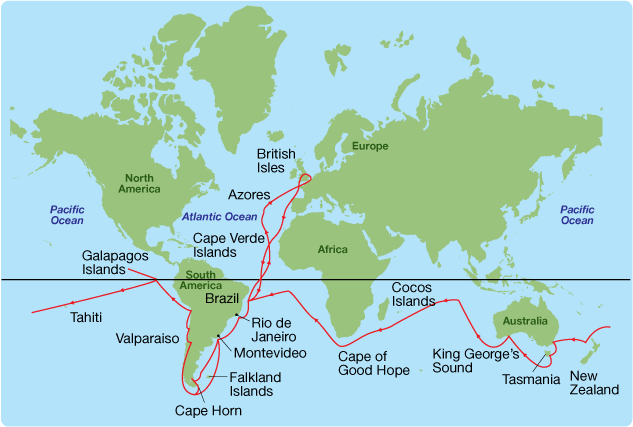
Darwin travelled from England to South America to Australia and back to South America during his five-year voyage aboard the HMS Beagle. Observations he made in England and while exploring caused Darwin to ask many questions about the natural world. Read about Darwin’s observations and the questions that arose from them on pages 125 and 126 in the textbook. Read up to the heading “Further Evidence of Evolution” on page 126.
 Try This
Try This
TR 2. Answering Darwin’s Questions
Darwin used the answers to questions based on his observations to formulate his theory of natural selection. Go to your Lesson 2 Assignment to answer some of Darwin’s questions. The link for this assignment is found at the beginning of this lesson.
1.12. Page 3
Module 4—Mechanisms of Population Change
 Watch and Listen
Watch and Listen
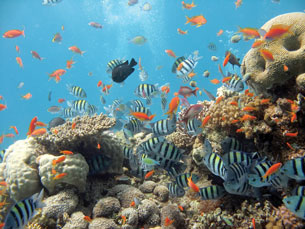
© Elisei Shafer/shutterstock
A lecture from the Howard Hughes Medical Institute, titled “Endless Forms Most Beautiful,” discusses Darwin’s life (his father worried he wouldn’t have a respectable profession) and how he developed his theory of evolution by natural selection. It is a lecture for high school students. The lecture reviews mutations, variations, and how natural selection works. The lecture is about an hour long and is very informative and interesting. You may prefer to watch this at two separate times.
In order to find this video, you need to do a web search. It is easy to find if you type in the keywords “endless forms most beautiful evolution lecture.” Scroll down the page about halfway to find the link for the video lecture. In your web search you may also find summaries of the book titled “Endless Forms Most Beautiful,” written by the lecturer Dr. Sean Carroll. Reading these summaries may also help you understand the lecture.
This lecture is an excellent summary of much of what you will learn about Charles Darwin and his theories.
 Self-Check
Self-Check
S4. Complete this Self-Check exercise after you have accessed the “Endless Forms Most Beautiful” lecture. Even if you did not explore this lecture in great depth, you will be able to answer some of the questions in this Self-Check based on your readings so far.
 Watch and Listen
Watch and Listen
The following animation reviews Darwin’s theory of evolution and natural selection. Watch “Darwin’s Theory of Evolution and Natural Selection” to discover the theory behind evolution by natural selection.
 Read
Read
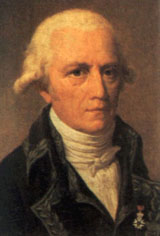
In the same year Charles Darwin was born, Jean-Baptiste Lamarck published his theory about how species change over time. Lamarck compared fossils with current species and noticed a progression of changes from the fossil structures to the current species. He believed that species have been increasing in complexity over time in order to achieve a level of perfection. Lamarck proposed that organisms could pass on developed characteristics (for example, big muscles from working out) by the inheritance of acquired characteristics.
 Watch and Listen
Watch and Listen
Comparing Theories
Watch this animated presentation that compares the theories of evolution by Lamarck and Darwin. Make note of the similarities and differences between these theories.
1.13. Page 4
Module 4—Mechanisms of Population Change
 Read
Read
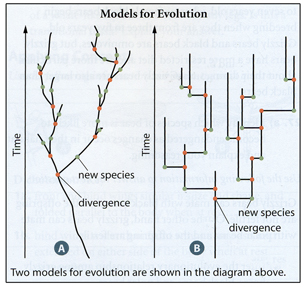
Inquiry into Biology u2_p.150, from McGraw Hill Reproduced by permission.
Darwin’s theory of evolution by natural selection remains the basis of many people’s understanding of evolution. However, scientific debate about the pace of evolution continues. Modern-day scientists propose two models: gradualism and punctuated equilibrium. Read “The Pace of Evolution” on page 140 in the textbook.
gradualism: gradual change occurs in a steady, linear way over time
punctuated equilibrium: evolutionary history is said to consist of long periods of equilibrium, interrupted by periods of speciation
 Try This
Try This
TR 3. The Pace of Evolution
You will look at which theory—in your opinion—best explains evolution. You will also compare and contrast gradualism with punctuated equilibrium. Go to your Module 4: Lesson 2 Assignment to answer the questions for this Try This activity.
1.14. Page 5
Module 4—Mechanisms of Population Change
 Reflect and Connect
Reflect and Connect
Applying and Comparing Theories of Evolution
This Reflect and Connect activity allows you to compare and apply the theories of Darwin and Lamarck. Go to your Module 4: Lesson 2 Assignment to complete this activity.
 Reflect on the Big Picture
Reflect on the Big Picture
You have now been introduced to some of the scientists who shaped Darwin’s thinking. Darwin knew about Lamarck’s theory of evolution when he came up with his own theory of evolution and natural selection. You need to incorporate this new information into your Module Project.
Project Hint
- If you are creating a game, perhaps ”Natural Selection” could be a space you land on. If you have an adaptation, you can survive and reproduce (roll again or gain players). If a player enters a new environment on the game board (for example, a swamp), he or she may not be well-adapted (lose a turn or lose life points).
- If you are writing a play or a podcast, you could have Darwin and Lamarck as arm-wrestling characters who are discussing their beliefs.
These are only examples of how to incorporate the information from Lesson 2 into your Module Project. You may use the given examples or come up with your own ideas. Discuss some creative ideas for your project.
Continue working on your Module Project.
- You should now have enough information to answer question 4. Jot down notes to answer the question “How do the Lamarckian and Darwinian explanations of evolutionary change compare?”
- Brainstorm ways that this information could be in your game, play, or podcast.
- Look back at the project work you placed in your course folder in Lesson 1.
- Begin creating your game rules/setup or the plot outline for your play.
 Module 4: Lesson 2 Assignment
Module 4: Lesson 2 Assignment
Remember to submit the Assignment answers to your teacher as part of your Module 4: Lesson 2 Assignment.
1.15. Page 6
Module 4—Mechanisms of Population Change
 Lesson Summary
Lesson Summary
In this lesson you explored the following essential questions:
- How do theories explaining evolutionary change compare?
- What theories attempt to explain the pace of evolutionary change?
In this lesson you examined theories that led Charles Darwin and Jean-Baptiste Lamarck to create their own theories about evolution. Both scientists believed that organisms with beneficial adaptations to the environment would survive.
The difference between the theories is how these organisms obtained their adaptations. Lamarck believed organisms could acquire their adaptations during their lifetimes, whereas Darwin thought that organisms were born with traits, which were then selected by nature. Over time, Darwin proposed that these beneficial traits would build up in a population, causing the population to change or evolve.
In Lamarck's view, evolution occurs within a single generation or within a few generations. Darwin's view suggests that evolution occurs over many generations and a long period of time. Many modern scientists accept Darwin’s theory of evolution by natural selection to be true. However, there is debate about the pace of evolution. Does evolution happen gradually or in punctuated bursts of divergence?
As you learn more about evolution, you will find that it is still an evolving topic in science. The discovery of new species and a risk of the loss of other species continues to keep people thinking about evolution as changes in climate and the development of natural habitats take place. In Lesson 3 you will look at the evidence scientists use to prove evolution has occurred and the evidence they use to study evolutionary relationships.
Lesson Glossary
hypothesis: a statement that provides one possible answer to a question or one possible explanation for an observation
inheritance of acquired characteristics: the theory that characteristics acquired during an organism’s lifetime could be passed to its offspring
fossils: the remains of past life found in sedimentary rock
paleontology: the study of ancient life through the examination of fossils
gradualism: gradual change occurs in a steady, linear way over time
punctuated equilibrium: evolutionary history is said to consist of long periods of equilibrium, interrupted by periods of speciation
1.16. Lesson 3 Intro
Module 4—Mechanisms of Population Change
Lesson 3—Evidence for Evolution
 Get Focused
Get Focused
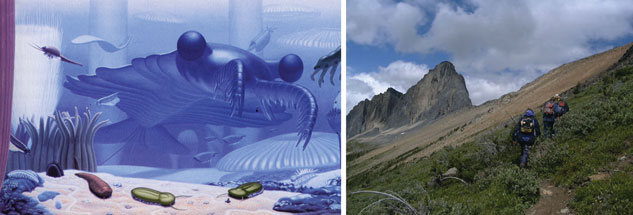
Helene Colbourne et al, Inquiry into Biology (Toronto: McGraw-Hill Ryerson, 2007), fig. 4.9A p. 127. Reproduced by permission. (left)
Courtesy of Todd Radenbaugh (right)
The images you have just looked at are of the Burgess Shale in Yoho National Park. The image on the left shows a creature from over 505 million years ago, during the Cambrian Period. The image on the right is from Yoho National Park today.
In Lesson 2 you learned about Darwin’s theory of natural selection, and you can use that theory to explain why some organisms survive and others do not. What proof do you have that natural selection is a usable theory? Fossils, like the ones in the Burgess Shale, can show that organisms have changed over time or have evolved. What other evidence is used by scientists to support and study evolution?
In this lesson you will explore the following essential question:
- What proof is there that present-day species evolved from ancestral forms?
 Module 4: Lesson 3 Assignment
Module 4: Lesson 3 Assignment
Your teacher-marked Module 4: Lesson 3 Assignment requires you to submit a response to the following:
- Reflect and Connect
You can access your Module 4: Lesson 3 Assignment. You can print off the assignment or save the download to your computer. Your answers can be saved on this document to your course folder.
1.17. Page 2
Module 4—Mechanisms of Population Change
 Explore
Explore
 Read
Read
A variety of evidence for evolution exists. This includes the following:
- fossils
- biogeography
- anatomy
- embryology
- molecular biology and genetics
 Watch and Listen
Watch and Listen
The following animation is the first of several that will appear throughout this lesson. Each one looks at a piece of evidence that supports Darwin’s theory of evolution. The first animation deals with fossils and supports what you will read here and in the textbook.
 Read
Read
Evidence for Evolution—Fossils
You have probably seen fossils like the ones in this photo. They are trilobites, and these organisms don’t exist today. Trilobite fossils can be found in Alberta and all over the world. Trilobites became extinct about 245 million years ago, but at one time there were more than 17 000 different species of them. The closest living relative to trilobites is likely the horseshoe crab.
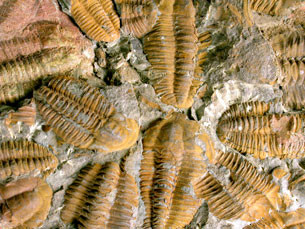
© Ismael Montero /Dreamstime
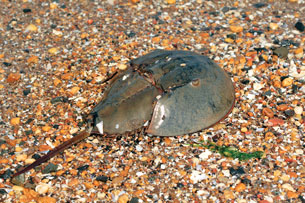
© Jessica Fitzel/Dreamstime
Fossils appear in chronological order in the rock layers, or strata. Studying the order of the fossils can help determine their age. The order of the fossils can also help scientists organize evolutionary family trees. Fossils can help show the evolutionary lines between ancestors and living species.
This animated image shows how fossils in the different strata layers can give valuable information to scientists.
Read the sections titled “The Fossil Record” and “Transitional Fossils” in the textbook, starting on page 126 and continuing to page 130. One example of a transitional fossil discussed in the textbook is Archaeopteryx. Click here to confirm your understanding of transitional fossils.
 Self-Check
Self-Check
SC 1. Why is Archaeopteryx considered a transitional fossil?
 Self-Check Answer
Self-Check Answer
SC 1. Archaeopteryx has characteristics of both reptiles (dinosaurs) and birds. It had feathers, but it also had teeth, claws, and a bony tail.
 Try This
Try This
Many movies portray prehistoric cave dwellers and dinosaurs living together. Was this really possible? Did birds evolve before or after fish? Use “Figure 4.10” on page 128 of the textbook to answer these questions. Study the geological time scale, and then try to complete the puzzle that follows.
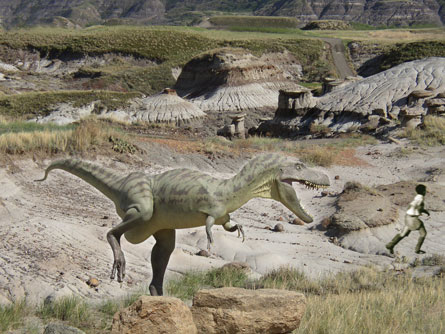
A common misconception is that humans and dinosaurs lived on Earth at the same time. Humans actually evolved over 55 million years after the dinosaurs became extinct! Dinosaurs fascinate children and adults alike. It is hard to imagine such different creatures roaming Earth.
 Read
Read
Evidence for Evolution—Patterns of Distribution
Biogeography is the study of the past and present geographical distribution of organisms. At one time, all of the continents were linked together and referred to as Pangaea. The movement of the continental plates helps to predict when and where animals evolved. View this information, and then read “Patterns of Distribution” on page 130 in the textbook.
 Self-Check
Self-Check
SC 2. How many million years ago did South America and Africa break apart?
SC 3. When did India become part of Asia?
SC 4. Why are similar fossils of the reptile Cynognathus found in Africa and South America?
SC 5. Why are there no polar bears in Antarctica or penguins at the North Pole?
 Self-Check Answers
Self-Check Answers
SC 2. They broke apart from 110 to 120 million years ago.
SC 3. India became part of Asia from 23 to 30 million years ago.
SC 4. Africa and South America were once joined in one “supercontinent.”
SC 5. Antarctica and the North Pole were not connected when penguins and polar bears evolved.
1.18. Page 3
Module 4—Mechanisms of Population Change
Evidence for Evolution—Anatomy
 Read
Read
homologous structures: body parts in different species that have the same evolutionary origins and structural elements but may have different functions
analogous structures: body parts in different species that have similar functions but evolved separately
Read “Anatomy” on pages 130 to 132 of the textbook. Homologous and analogous structures are discussed. There is also a graphic you can view that supports these definitions.
 Self-Check
Self-Check
SC 6. Are the wings shown in the next photos examples of homologous structures or analogous structures?
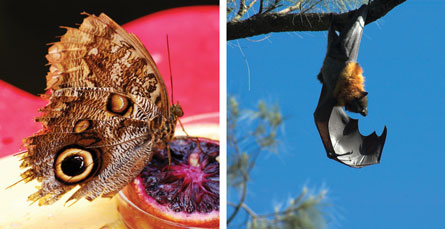
© Susinder /Dreamstime (bat)
© Manfredxy /Dreamstime (moth)
 Self-Check Answer
Self-Check Answer
SC 6. The wing examples are both analogous structures—they perform similar functions (flying) but do not have a common evolutionary origin.
 Watch And Listen
Watch And Listen
You may choose to view this graphic before you read up on embryology in the textbook. The graphic is a useful media support for the concepts presented here and in the textbook.
 Read
Read
Evidence for Evolution—Embryology
The embryos of different organisms have similar stages of development. It is not surprising that two closely related organisms are similar in both anatomy and development. The more closely related a species is to another species, the more similar the embryonic development. Read “Embryology” on page 132 in the textbook.
Evidence for Evolution—Molecular Biology and Genetics
Similarities between different species of DNA and protein structure indicate how closely related species are. Read “Molecular Biology” and “Genetics” on pages 132 and 133 in your textbook.
 Watch and Listen
Watch and Listen
1.19. Page 4
Module 4—Mechanisms of Population Change
 Reflect and Connect
Reflect and Connect
A student is on holiday and will be away for Lesson 3. Create a summary for the student so he or she can quickly catch up without missing important information. The summary can be visual, text-based, or a combination of the two. Your review may be in audio form, written, electronic, or video. It should review all the evidence for evolution learned about this lesson.
This is a part of your Lesson 3 Assignment. You will also be able to use this summary in the future as a reference and to help you study.
 Reflect on the Big Picture
Reflect on the Big Picture
Module Project
You have now explored different types of evidence for evolution. Now you can build this new knowledge into your game, play, or podcast. Maybe you want game players to collect bones as they travel around the board, as they build a fossil skeleton, or as they find a transitional fossil.
Will your players be quizzed on analogous structures? Or maybe they need to collect pieces of DNA to compare evolutionary lineages. Will your play include props? Maybe a fossil skeleton would create an interesting dialogue about evolution. Imagine what Darwin would say today had he known about genetics and DNA!
You may use all, some, or none of the noted ideas from the first three lessons in your Module Project, but it is now time to continue working on it.
- You should now have enough information to answer the essential questions from the first three lessons. Jot down notes to answer these questions.
- How do mutations create species variability?
- Why is sexual reproduction important to the process of evolution?
- How do theories explaining evolutionary change compare?
- What theories are the foundation of modern evolutionary change ideas?
- What proof is there that present-day species evolved from ancestral forms?
- Brainstorm ways that this information could be in your game, play, or podcast. Talk to other students about their ideas if you need some help.
- Look back at the project work you placed in your course folder in Lesson 2.
- Continue creating your game rules/setup or the plot outline for your play.
- Place what you have completed in your course folder to continue working with in the next lesson.
 Discuss
Discuss
Is the evidence for evolution discussed in this lesson enough to prove to you that evolution occurs? If not, what further evidence do you need? If it is enough evidence, what piece of evidence stood out for you? What area of evidence would you like to explore in more depth? Create a response to these questions, and post your response in the discussion area.
 Going Beyond
Going Beyond
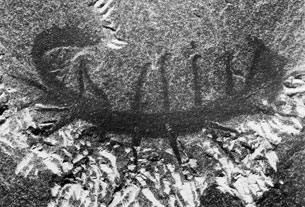
Reproduced with the permission of the Minister of Public Works and Government Services Canada, 2004 and Courtesy of Natural Resources Canada, Geological Survey of Canada.
The organism shown here is unique to the Burgess Shale. Some fossils in the shale have never been found anywhere else in the world. Work collaboratively with students in your class to do some research to find out what unique and interesting fossils have been found in the Burgess Shale. What have scientists learned from these fossils? Why is the Burgess Shale a protected area? Post your information in the discussion area. Create a poster or written summary of the information posted. This may be completed as a group.
 Module 4: Lesson 3 Assignment
Module 4: Lesson 3 Assignment
Remember to submit the Assignment answers to your teacher as part of your Module 4: Lesson 3 Assignment.
1.20. Page 5
Module 4—Mechanisms of Population Change
 Lesson Summary
Lesson Summary
In this lesson you explored the following essential question:
- What proof is there that present-day species evolved from ancestral forms?
The Burgess Shale in Yoho National Park is an excellent source of evidence for evolution. If Darwin had access to the fossils in the Burgess Shale, he likely would have had even stronger evidence to support his developing theories. Scientists today have more evidence for evolution than Darwin had.
Scientists have been accumulating evidence of evolution for more than 150 years. Early evidence—such as fossils—led scientists to examine anatomy. Homologous structures, which can be compared between fossils and living organisms, support Darwin’s theory that organisms evolve from ancestral forms. Similarities in embryo development (a three-week old human embryo looks similar to a chicken embryo) also seem to support Darwin’s theory.
New discoveries and the advancement of technology allow scientists to look at molecular biology and genetics (such as DNA and the process of cellular reproduction) for evidence of evolution. For example, scientists have found that human DNA is 98.8% similar to chimpanzee DNA. This information indicates that at some point there was a common ancestor for the two animals.
In Lesson 4 you will explore how new species form, and you will revisit contrasting ideas about the pace of evolution.
Lesson Glossary
analogous structures: body parts in different species that have similar functions but evolved separately
biogeography: the study of the past and present geographical distribution of species
embryology: the study of similar features in embryos and evolutionary relationships that may exist
fossils: the remains of past life found in sedimentary rock
homologous structures: body parts in different species that have the same evolutionary origins and structural elements but may have different functions
hypothesis: a statement that provides one possible answer to a question or one possible explanation for an observation
inheritance of acquired characteristics: a theory that characteristics acquired during an organism’s lifetime could be passed to its offspring
strata: a layer of rock or soil that has a consistent character and is different from layers above and below it
transitional fossil: the remains or impression of a prehistoric organism that shows intermediary links between groups of organisms and shares characteristics common to these groups
1.21. Lesson 4 Intro
Module 4—Mechanisms of Population Change
Lesson 4—How New Species Form
 Get Focused
Get Focused
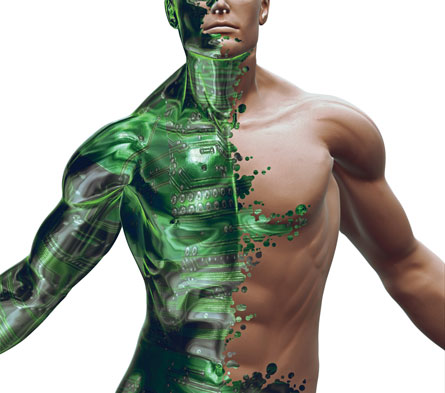
© Antony Papantoniou /Dreamstime
speciation:the formation of new species
What does it take to make a new species? In movies, a radical mutation in human DNA will often create a weird superhuman. Or a human will be infected with an unknown virus and become a blood-seeking creature. This looks great on the big screen, but does it really portray a new species of homo sapiens? Maybe, but certain conditions apply—random mutations definitely direct the evolutionary path of speciation. However, there are conditions that allow these mutations to create a whole new species.
In this lesson you will explore the following essential question:
- What conditions are necessary for speciation?
 Module 4: Lesson 4 Assignment
Module 4: Lesson 4 Assignment
Your teacher-marked Module 4: Lesson 4 Assignment requires you to submit a response to the following:
- TR 2. Leopard Frogs: One Species or Seven?
- Reflect and Connect
1.22. Page 2
Module 4—Mechanisms of Population Change
 Explore
Explore
 Read
Read
Darwin’s theory of evolution by natural selection included these ideas.
- Life forms have developed from ancestral species.
- All living things are related to one another by varying degrees of common descent.
- All living things on Earth have a common origin or share a common ancestor.
- The mechanism by which one species evolves into another species involves random heritable genetic mutations. Mutations that create a survival advantage are more likely to be passed on to offspring. Eventually, the successful mutation increases in the population and causes the population as a whole to start to change.
viable offspring: offspring that are healthy and able to reproduce and create new offspring
What is a species? A species is defined by considering an animal’s anatomy, physiology, biochemistry, behaviour, and genetics. And a species is a group of similar organisms that can interbreed to produce viable offspring in nature. Viable offspring will live and be able to reproduce to create new offspring. The formation of new species is called speciation. Two forms of speciation are transformation and divergence.

Inquiry into Biology u2_S4.3_p.137, from McGraw Hill Reproduced by permission.
With transformation, new species arise as a species gradually changes over time and the old species is replaced by the more adapted species. One species evolves into another species (one path).

The evolution of mammoths is an example of speciation by transformation. Read more about this subject on page 136 of the textbook.
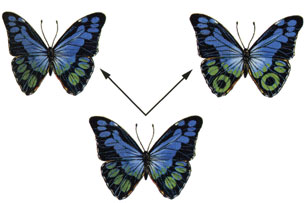
Inquiry into Biology u2_S4.3_p.137, from McGraw Hill Reproduced by permission.
Meanwhile, with divergence, new species can arise when barriers prevent populations from reproducing with each other. In this case, two or more species evolve from one parent species (many paths).
The evolution of the Galapagos Island finches is an example of divergence. Read more about this topic in “Figure 4.16” on page 137 of the textbook.
1.23. Page 3
Module 4—Mechanisms of Population Change
 Watch and Listen
Watch and Listen
What are the requirements for evolution and the creation of a new species? The following animation provides the answer to this question.
 Read
Read
A population must be isolated in some way for speciation to occur. Read “Keeping Populations Separate” on pages 137 and 138 of the textbook to find out how this isolation can occur. The animation also covers this topic.
 Self-Check
Self-Check
SC 1. What two types of barriers can prevent interbreeding?
SC 2. A bird’s call can be a barrier to speciation. How?
 Self-Check Answers
Self-Check Answers
SC 1. A geographical barrier keeps populations physically separated from one another. Examples include canyons, mountain ranges, water between islands, large lava flows, and glaciers.
With a biological barrier, organism ranges may overlap but biological barriers prevent reproduction. Courtship/mating rituals, pheromones, behaviour, niche/habitat preferences, and reproductive anatomy differences are examples of biological barriers.
SC 2. Bird calls play a large role in mate selection. Variations in calls may affect the ability of males to attract female mates. Intraspecific variations in calls can lead to reproductive isolation.
 Watch and Listen
Watch and Listen
Read more about speciation and adaptive radiation on pages 139 and 140 of the textbook.
 Self-Check
Self-Check
SC 3. Give an example of adaptive radiation.
SC 4. Why is this species an example of adaptive radiation?
 Self-Check Answers
Self-Check Answers
SC 3. Darwin’s finches or the Drosphila fly of the Hawaiian Islands are examples of adaptive radiation.
SC 4. Both species had an original isolated population on one island. The species proliferated on the first island and then began to disperse to other islands. They adapted to the different conditions on each separate island. Various selective pressures resulted in different feeding and mating habits.
 Try This
Try This
TR 1. Biological Barriers
Print or save a copy of the “Biological Barriers” handout. Read and answer the questions. Save this data in your course folder. Compare your answers with the answer key. This will be a helpful review and may be used in your Module Project.
1.24. Page 4
Module 4—Mechanisms of Population Change
 Watch and Listen
Watch and Listen
Speciation caused by a geographical barrier is sometimes referred to as allopatric speciation. The cichlids (a genus of fish) in Lake Victoria are an example of allopatric speciation. Watch the example of how a geographical barrier can cause allopatric speciation in a population of lizards. Choose "3.71 Allopatric Speciation" from the list.
 Try This
Try This
TR 2. Leopard Frogs: One Species or Seven?

© Gilles DeCruyenaere/shutterstock
Have you ever considered that not all “ribbits” sound the same? In fact, they can be very different. Read “Thought Lab 4.5” on page 139 of the textbook. Listen to the frog calls provided below. Go to your Lesson 4 Assignment to complete this activity.
 Read
Read
You have already looked at the theory of punctuated equilibrium vs. gradualism in Lesson 2. You may wish to refresh your memory and reread pages 140 and 141 of the textbook. If you would like to learn more about punctuated equilibrium, try typing the keywords “punctuated equilibrium” into the pbs.org website. Now that you know more about how new species arise, are you more inclined to follow one theory?
 Self-Check
Self-Check
SC 5. Which of the two models, gradualism or punctuated equilibrium, suggests that species undergo most of their changes when they first diverge from the ancestral parent species?
 Self-Check Answer
Self-Check Answer
SC 5. Punctuated equilibrium is the correct answer.
1.25. Page 5
Module 4—Mechanisms of Population Change
 Reflect and Connect
Reflect and Connect
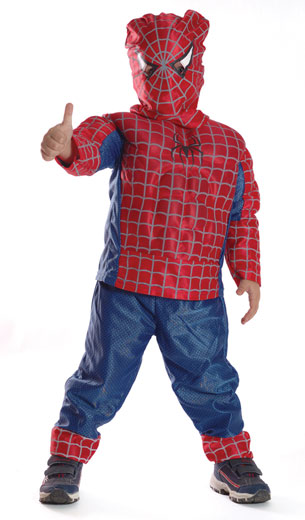
© Mati Dovner/shutterstock
What conditions would need to be present for Peter Parker to become a new species as Spiderman? Outline a scenario in a storytelling format (e.g., as a cartoon, a creative writing piece, a video, or an audio) that would describe how the “spiderman” species could evolve from the current population of humans. Be creative, but don’t get carried away—this is designed to be a short piece.
OR
Create your own scenario outlining the evolution of a new species by using a storytelling format of your choice.
You will be completing this activity in your Module 4: Lesson 4 Assignment.
The following rubric will determine your mark for this exercise.
Category |
4 |
3 |
2 |
1 |
Requirements |
The requirements are met and exceeded. |
All requirements are met. |
One requirement was not completely met. |
More than one requirement was not completely met. |
| Content | The topic is covered in-depth with details and descriptions. The student’s subject knowledge is excellent. |
Essential knowledge about the topic is included. The student’s subject knowledge appears to be good. |
Essential knowledge is included about the topic, but there are one or two factual errors. |
The content is minimal, or there are several factual errors. |
| Presentation |
 Self-Check
Self-Check
SC 6. As a final check of what you have learned in this lesson, test yourself with the following questions.
 Reflect on the Big Picture
Reflect on the Big Picture
Module Project
Consider how to bring the concept of “barrier” into your game.
Maybe your game players will diverge into a new species when they land on the “barrier” square. Will your play characters debate the merits of one model over the other, or even act out the punctuated equilibrium theory? There are so many possibilities—what will you do? These are just some ideas you may use, or not use, to help finish your game, play, or podcast.
Complete the Module Project.
- You now have the information to answer the final question for this project. Jot down important information that answers the last question: What conditions are necessary for speciation?
- Brainstorm ways to include this information into your project in a creative way.
- Retrieve your project materials from your course folder.
- Complete the project.
- Have you referred to the marking rubric to self-assess your project? If not, do so now.
- Submit the finished project to your teacher as your module assessment. Share your projects with your classmates.
 Going Beyond
Going Beyond
The fossil record indicates that humans have changed over time. The documentary titled “Becoming Human” explores the evidence for human evolution, anatomical differences between modern-day humans and their ancestors, human lineages, and cultural evolution. You will travel with paleontologists across continents, visit dig sites, and look at ancient fossils of early humans.
As you view the documentary, pay attention to the changes in structure and culture that make people what they are today. To access this video, type in the keywords “becoming human documentary.”
This website has lots of information that is interesting and worthwhile to view.
 Self-Check
Self-Check
 Module 4: Lesson 4 Assignment
Module 4: Lesson 4 Assignment
Remember to submit the Assignment answers to your teacher as part of your Module 4: Lesson 4 Assignment.
1.26. Page 6
Module 4—Mechanisms of Population Change
 Lesson Summary
Lesson Summary
In this lesson you explored the following essential question:
- What conditions are necessary for speciation?
Divergence and transformation are the two pathways in which new species can evolve. All of the estimated two to 100 million species in the world have evolved from these two pathways. But in order for a species to diverge or transform, certain conditions must be present.
Essential to evolution is genetic diversity. A population must have genetic variation in order for any kind of change to be possible. Mutations, sexual reproduction, and recombinations provide this genetic diversity.
An environment must change in some way in order for certain characteristics to become dominant in a population. The change in environment (either geographical or biological) must create reproductive isolation. This isolation prevents the two populations from exchanging genetic information. Adaptations in each population can eventually lead to the genesis of a new species. Speciation has occurred if the two populations can no longer mate successfully.
Now that you have completed the last lesson of Unit B: Module 4, there are three things you need to do.
First, hand in your Lesson 4 Assignment.
Second, you have been working on a module project. It is now time to finish your play, game, or podcast. This has been discussed in Reflect on the Big Picture.
Finally, you need to head to the Unit Summary and Assessment. There you will find a Unit Assessment that you should start working on.
Once all of these tasks have been completed, you will be ready to move from “Ecosystems and Population Change” to “Photosynthesis and Cellular Respiration.”
Lesson Glossary
allopatric: speciation that occurs from a geographical barrier
barrier: anything that prevents organisms from reproducing
biological barrier: a factor such as behaviour that keeps species reproductively isolated even when they exist in the same region
divergence: the development of one or more new species from a parent species as a result of mutation and adaptation to changing environmental conditions: the parent species continues to exist
geographical barrier: geological formations that keep organisms separated
gradualism: the theory that evolution occurs slowly and steadily in a linear fashion
punctuated equilibrium: the theory that suggests that evolutionary history consists of long periods of stasis (stable equilibrium), punctuated by periods of divergence
speciation: the formation of new species
transformation: the evolution of one species into another as a result of mutation and adaptation to changing environmental conditions, resulting in the replacement of the old species
viable offspring: offspring that are healthy and able to reproduce and create new offspring
1.27. Module Summary/Assessment
Module 4—Mechanisms of Population Change
 Module Summary
Module Summary
“It is not the strongest of the species that survives, nor the most intelligent that survives. It is the one that is the most adaptable to change.”
Charles Darwin – The Origin of Species
In this module you studied the mechanisms of population change and learned how changes in population can lead to evolution. Evolution is the change in populations over time. Variations are essential to a population’s survival. The variations or differences between individuals are created through sexual reproduction and mutations. Populations with greater variation are more likely to survive if their environment changes. Variations that give an organism an advantage are called adaptations.
In Lesson 2 of this module, you investigated past and present theories on which biologists base their theories. Two early theorists—Lamarck and Darwin—proposed theories of evolution and population change. A comparison of these two scientists showed that they had different ideas about how population characteristics changed over time. Darwin’s theory of natural selection is the theory that is widely accepted today, and it is used to explain how nature is involved in population change.
Throughout this module you read articles and viewed examples of populations evolving. These changes were explained by the theory of natural selection. Natural selection dictates that organisms most suited to survive in an environment because of their adaptations will live to reproduce and pass on these adaptations. Today’s scientists also have two theories proposing the rate of evolution. You studied the two different models—gradualism and punctuated equilibrium. The gradualism model describes evolution as a slow, steady, and continuous process; whereas the punctuated model describes evolution as a process that occurs in rapid bursts followed by long periods of little change. The speed at which evolution occurs is still up for debate, but scientists agree that populations have changed over time and evolution has occurred.
There is much evidence to support evolution. Some of this evidence was studied in Lesson 3. The fossil record has given scientists information about evolution for many years. Comparative anatomy and embryology are useful tools for distinguishing evolutionary relationships between different species of organisms. Biogeography, genetics, and biochemistry are some other areas of study where evidence for evolution can be found.
In the final lesson of this module, you learned about the methods by which new species can evolve. In order for change to occur, variation must be present in a population. There also must be environmental changes that encourage natural selection. Finally, there must be reproductive isolation. Barriers, such as geographical isolation or biological isolation, effectively prevent two populations from interbreeding. Over time, each population adapts to its environment. If the adaptations have become so different that successful mating will not occur, then speciation has taken place.
This module has allowed you to investigate the history of organisms on Earth. It also allows you to explain the process of evolution by looking at scientific theory and evidence supporting those theories. With this information, you can predict possible evolutionary outcomes based on your knowledge of natural selection and speciation.
 Module Assessment
Module Assessment
Module Project
Submit your Module Project to your teacher to be marked. Make sure that all of the following items have been covered. You will be working on this project through each lesson. At the end of Lesson 4 you will need to prepare the game, play, or podcast for submission. Use the self-evaluative chart to support a reflection on how well you used the focus questions in this project. Your teacher may request that your project be posted or shared with your peers.
A planning template to help you organize your project is available for download in Lesson 1 or here.
Purpose: Demonstrate your understanding of Module 4 by creating a game, podcast, or play that will educate people about evolution in a creative, fun, and entertaining way.
Requirements: The questions from the Get Focused section at the beginning of each lesson must be answered and explored while playing the game or watching the play or podcast. A checklist follows that is designed to help ensure you have included the necessary information in this project.
Choose Option A or B.
Option A—The Game of Evolution
Game Specifics
- The game must be “playable.”
- The game may be a board game, a card game, a trivia game, or in an electronic format. You may modify an existing game to meet your needs.
- A list of game rules should be included.
- The game board and pieces should all be based on a theme (something to do with evolution).
- The game must educate and entertain.
- All seven questions (in the following table) must be addressed and understood by the players by the end of the game.
- A completed copy of the Project Questions Self-Checklist and Marking Rubric must be included with your project.
Option B—Evolution: The Play or Podcast
Play Specifics
- The play may be in the form of a manuscript or an audio or video recording.
- You may modify an existing play to meet your needs or create an original play.
- The play must educate and entertain.
- All seven questions (in the following table) must be addressed and understood by the audience at the end of the play.
- A completed copy of the Project Questions Self-Checklist and Marking Rubric must be included with your project.
Project Questions Self-Checklist
Check the appropriate box.
Questions to Be Explored and Answered in the Project |
I thoroughly and correctly explained this question. |
I correctly explained this question. |
I made an attempt to explain this question. |
I did not attempt to explain this question. |
How is sexual reproduction significant in creating variation within populations? |
|
|
|
|
How can mutations improve or harm an individual organism’s chance for survival and reproduction? |
|
|
|
|
How do variations lead to evolution of populations? |
|
|
|
|
How do the Lamarckian and Darwinian explanations of evolutionary change compare? |
|
|
|
|
What evidence exists to support the theory of evolution? |
|
|
|
|
What is speciation and what conditions are required for this process? |
|
|
|
|
How do scientists currently explain evolution? |
|
|
|
|
Marking Rubric
|
4 |
3 |
2 |
1 |
|
Questions to Be Explained and Answered |
All seven questions are thoroughly explained and answered by playing or watching the project. |
Most of the seven questions are explained and answered by playing or watching the project. |
Some of the seven questions are explained and answered by playing or watching the project. |
Few or none of the seven questions are explained and answered by playing or watching the project. |
____ x 5 = ___/20 |
Scientific Content |
The scientific content is correct and at an appropriate level for a Biology 20 student. |
The scientific content is mostly correct and at an appropriate level for a Biology 20 student. |
The scientific content has some errors. |
The scientific content contains many errors. |
____ x 2 = ___/8 |
Entertainment Value |
The project was very entertaining and fun. |
The project was entertaining. |
The project had some entertainment value. |
The project showed little or no entertainment value. |
____ x 1 = ___/4 |
|
PROJECT |
____/32 |
|||
1.28. Module Glossary
Module 4—Mechanisms of Population Change
Module Glossary
adaptation: a beneficial variation that helps an organism survive
allopatric: speciation that occurs from a geographical barrier
analogous structures: body parts in different species that have similar functions but evolved separately
barrier: anything that prevents organisms from reproducing
biogeography: the study of the past and present geographical distribution of species
biological barrier: a factor such as behaviour that keeps species reproductively isolated even when they exist in the same region
divergence: the development of one or more new species from a parent species as a result of mutation and adaptation to changing environmental conditions: the parent species continues to exist
embryology: the study of similar features in embryos and evolutionary relationships that may exist
fossils: the remains of past life found in sedimentary rock
geographical barrier: geological formations that keep organisms separated
gradualism: the theory that evolution occurs slowly and steadily in a linear fashion
gradualism: gradual change occurs in a steady, linear way over time
homologous structures: body parts in different species that have the same evolutionary origins and structural elements but may have different functions
hypothesis: a statement that provides one possible answer to a question or one possible explanation for an observation
inheritance of acquired characteristics: a theory that characteristics acquired during an organism’s lifetime could be passed to its offspring
mutagen: something that causes an increased rate of mutation
mutation: a change in the genetic material of an organism (DNA)
natural selection: the process that results when the characteristics of a population of organisms change because individuals with certain inherited traits survive specific local environmental conditions and, through reproduction, pass on their traits to their offspring
paleontology: the study of ancient life through the examination of fossils
punctuated equilibrium: evolutionary history is said to consist of long periods of equilibrium, interrupted by periods of speciation
punctuated equilibrium: the theory that suggests that evolutionary history consists of long periods of stasis (stable equilibrium), punctuated by periods of divergence
selective advantage: an organism’s variations increase its chances of surviving
selective disadvantage: an organism’s variations reduce its chances of surviving
selective pressure: environmental conditions that select for certain characteristics of individuals and select against other characteristics
sexual selection: a type of natural selection where characteristics are selected based on mate preferences
speciation: the formation of new species
strata: a layer of rock or soil that has a consistent character and is different from layers above and below it
transformation: the evolution of one species into another as a result of mutation and adaptation to changing environmental conditions, resulting in the replacement of the old species
transitional fossil: the remains or impression of a prehistoric organism that shows intermediary links between groups of organisms and shares characteristics common to these groups
variation: visible or invisible differences between individuals
viable offspring: offspring that are healthy and able to reproduce and create new offspring